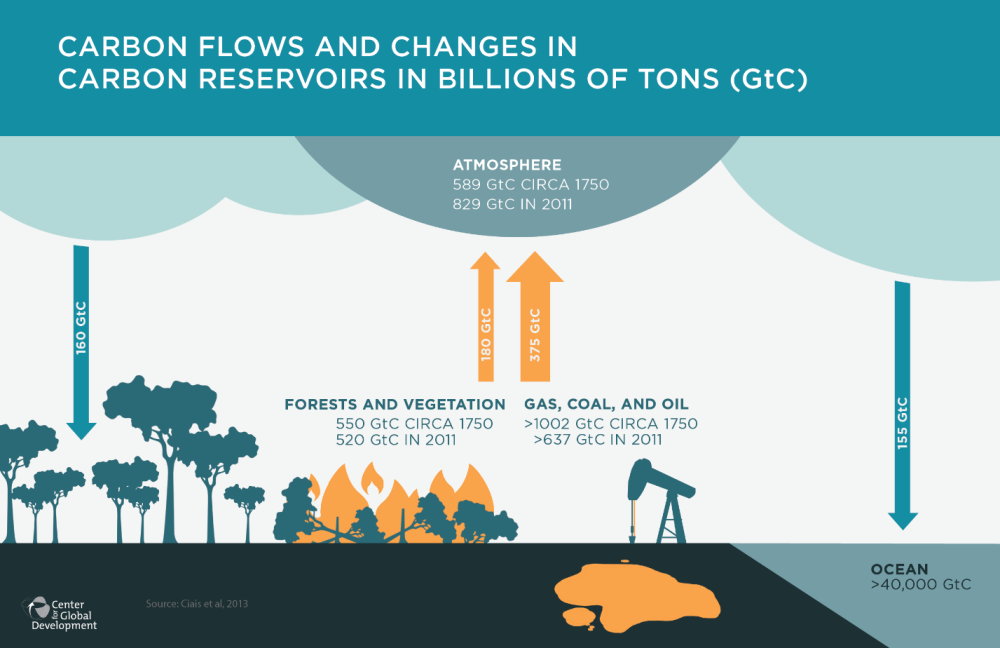No need to imagine “what if?” In fact, we already have a safe and natural technology for carbon capture and storage (CCS). It’s called “tropical forests.”
Related Content
That’s one of the key messages of a new CGD Working Paper by Dr. Rosa Goodman (Yale School of Forestry and Environmental Studies) and Prof. Martin Herold (University of Wageningen), “Why Maintaining Tropical Forests Is Essential and Urgent for a Stable Climate”.
Not just avoiding a source of emissions, but protecting a sink
To the extent that forests get airtime (not enough!) in discussions of climate change, the focus tends to be on the urgency of reducing tropical deforestation to mitigate a significant source of current greenhouse gas emissions. And indeed, Goodman and Herold summarize the science behind estimates that tropical deforestation releases up to 2.7 billion tons of carbon into the atmosphere each year—as much as 18 percent of global annual gross emissions—an amount as high as emissions from China in 2011.
But Goodman and Herold also stress the degree to which the world has been getting a free lunch, in the sense that standing forests—while they are still standing—have been absorbing a large portion of current emissions, thus slowing accumulation in the atmosphere. Tropical forest regrowth and the continuing carbon sequestration of mature forests removed 22-26 percent of all anthropogenic carbon emissions in the 2000s.
In a new blog, my colleague Jonah Busch explains how all the numbers fit together; I’ll restrict my focus to the role of forests as a carbon sink.
Three places where excess emissions can go
The figure below illustrates the total carbon flows and changes in carbon stocks since 1750 for fossil fuels, forests and vegetation, the oceans, and the atmosphere.

Excess emissions can end up in one of three places: they can be absorbed by forests and vegetation, they can accumulate in the atmosphere, or they can be absorbed by oceans. Carbon accumulation in the atmosphere or in the oceans, while natural, is not safe. The increasing concentrations of CO2 and other greenhouse gases in the atmosphere cause climate change and its many detrimental effects on human welfare, which, as my colleague Jonah Busch puts it, are awful for the rich but catastrophic for the poor. Increasing concentrations of CO2 in the oceans leads to higher acidity, wreaking havoc on marine life and associated food chains.
By contrast, carbon accumulation in forests is not only safe, but has important additional benefits, detailed here and here.
Cheaper, safer, and available now—but not a free lunch
Wikipedia tells me that “CCS is the process of capturing waste carbon dioxide (CO2) from large point sources such as fossil fuel power plants, transporting it to a storage site, and depositing it where it will not enter the atmosphere, normally an underground geological formation.” So maybe by this definition, the carbon sequestration and storage functions provided by tropical forests don’t count, but they should: unlike “brown” CCS, the “green” CCS technology provided by trees is safe and effective, and available now.
The International Energy Agency characterizes the progress of development and deployment of CCS technology as “woefully off pace.” And a paper published by the Belfer Center estimates that first-generation CCS plants would avert emissions at a cost of $100–150 per ton of CO2, declining to $30–50 per ton when the technology is more mature. This compares to an average price of $7.8 per ton of CO2 paid in 2012 for forestry offsets in the voluntary carbon market, according to Forest Trends.
So why would we be literally (as farmers or corporations in forest countries) or figuratively (as consumers or policymakers in rich countries) setting fire to the installed CCS capacity that we already have in the form of tropical forests?
Because in fact there is no such thing as a free lunch. While “green” CCS technology is still much cheaper than the “brown” alternative, it’s not really free. Owners of forest land or exploitation permits can usually make more money by converting forests to other uses, so there’s an opportunity cost. And governments incur both financial and political costs when they establish protected areas, increase law enforcement efforts, or undertake any number of other policy measures needed to maintain forests.
As I’ve said before, rich countries have not yet ponied up enough money to provide sufficient incentives to forest-rich countries to shift to low-carbon development paths. Keeping tropical forests standing not only avoids emissions, but maintains a CCS technology that’s already functioning. We should be willing to pay for it.
Disclaimer
CGD blog posts reflect the views of the authors, drawing on prior research and experience in their areas of expertise. CGD is a nonpartisan, independent organization and does not take institutional positions.





